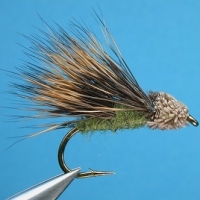2016/7/16 17:05:47

In my last article I discussed a few techniques in copying local insect life that feeding fish are taking to help increase your chances to land some. Here is another technique that can prove to be a saver on a difficult day when it’s looking like you will blank. So here is my simple guide to un-matching the hatch.
It is so obvious to try and mimic the insects that trout are taking on the river, stream or stillwater you are fishing but what do you do if they are still not interested in the flies you have put past them. This can be very frustrating as a large hatch has occurred and the trout are in a feeding frenzy but you cannot get a pull. The normal reaction is to change flies trying various patterns close to the insect the trout are feeding on however this can led to a lot of time wasted and possibly no takes. There are a lot of things to consider in relation to your casting technique, line density, tippet gauge etc. However one aspect of the set up is the fly. Instead of trying to match the insect try to use a fly that is completely opposite.
This involves a few things to consider, size colour and shape as before when trying to match but this time you want to try and exaggerate to the extreme within reason in the opposite direction. Say for instance they are feeding on a small light green upright winged fly and you have tried to match this but no takes have been coming. So now it’s time to try a larger dark coloured fly within a team of possibly three flies. Or for instance they are feeding on a nymph just below the surface the nymph is dark in colour so you would want to try something brighter, larger and in contrast to the nymph they are feeding on. Fluorescent colourful flies are also worth a go as the contrasting colour will gain their attention and hopefully result in takes.
Another thing to consider is the action of the fly, as before when matching we would try to mimic the insects movement, this time however you want to do something completely different. In the winged example given I would opt for a high floating fly say tied using deer hair or equivalent and wake the fly through the feeding trout trying to get their attention with the movement of water above them. I have found that it works better if you have a team of flies on the line. The trout notice the first pass them by and takes the second or third. I wouldn’t go any more than three though as it leads to more chance of foul ups which will eat into your time.
A hatch of flies can happen very suddenly and if you are prepared to act and put in time matching the hatch and then un-matching the hatch you should be rewarded with some nice trout. It can all be over in a few moments so act quickly and hopefully you will save the day.
Most of those who have experienced fishingin Louisiana know that there are plenty of mari
Hilton Head Island On A Budget
Hilton Head Island is one of the most popular vacation destinations in the entire world, and many p
Essential Details For Fishing Clothing Simplified
Are you interested in a hobby that can &
Contact management E-mail : [email protected]
Copyright © 2005-2016 Outdoor sports All Rights Reserved